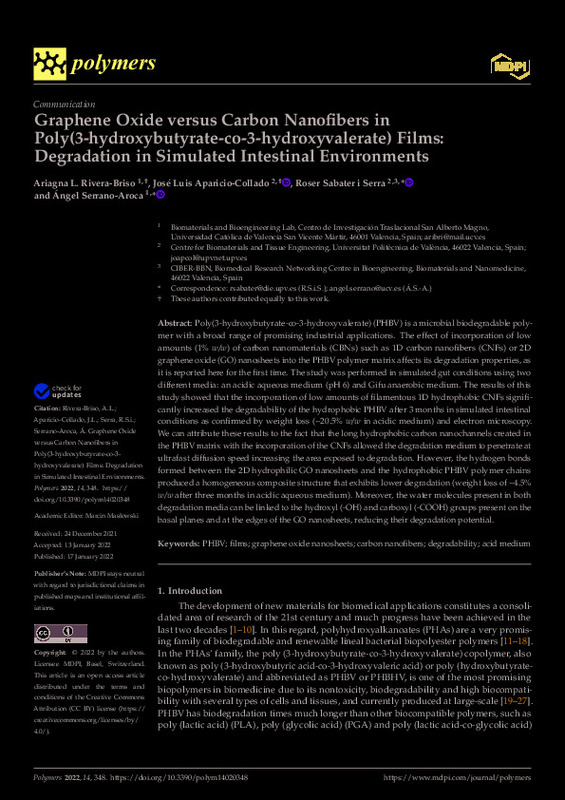JavaScript is disabled for your browser. Some features of this site may not work without it.
Buscar en RiuNet
Listar
Mi cuenta
Estadísticas
Ayuda RiuNet
Admin. UPV
Graphene Oxide versus Carbon Nanofibers in Poly(3-hydroxybutyrate-co-3-hydroxyvalerate) Films: Degradation in Simulated Intestinal Environments
Mostrar el registro sencillo del ítem
Ficheros en el ítem
| dc.contributor.author | Rivera-Briso, Ariagna L.
|
es_ES |
| dc.contributor.author | Aparicio-Collado, José Luís
|
es_ES |
| dc.contributor.author | Sabater i Serra, Roser
|
es_ES |
| dc.contributor.author | Serrano-Aroca, Ángel
|
es_ES |
| dc.date.accessioned | 2023-05-10T18:01:25Z | |
| dc.date.available | 2023-05-10T18:01:25Z | |
| dc.date.issued | 2022-01 | es_ES |
| dc.identifier.uri | http://hdl.handle.net/10251/193243 | |
| dc.description.abstract | [EN] Poly(3-hydroxybutyrate-co-3-hydroxyvalerate) (PHBV) is a microbial biodegradable polymer with a broad range of promising industrial applications. The effect of incorporation of low amounts (1% w/w) of carbon nanomaterials (CBNs) such as 1D carbon nanofibers (CNFs) or 2D graphene oxide (GO) nanosheets into the PHBV polymer matrix affects its degradation properties, as it is reported here for the first time. The study was performed in simulated gut conditions using two different media: an acidic aqueous medium (pH 6) and Gifu anaerobic medium. The results of this study showed that the incorporation of low amounts of filamentous 1D hydrophobic CNFs significantly increased the degradability of the hydrophobic PHBV after 3 months in simulated intestinal conditions as confirmed by weight loss (~20.5% w/w in acidic medium) and electron microscopy. We can attribute these results to the fact that the long hydrophobic carbon nanochannels created in the PHBV matrix with the incorporation of the CNFs allowed the degradation medium to penetrate at ultrafast diffusion speed increasing the area exposed to degradation. However, the hydrogen bonds formed between the 2D hydrophilic GO nanosheets and the hydrophobic PHBV polymer chains produced a homogeneous composite structure that exhibits lower degradation (weight loss of ~4.5% w/w after three months in acidic aqueous medium). Moreover, the water molecules present in both degradation media can be linked to the hydroxyl (-OH) and carboxyl (-COOH) groups present on the basal planes and at the edges of the GO nanosheets, reducing their degradation potential. | es_ES |
| dc.description.sponsorship | This study was founded by the Fundación Universidad Católica de Valencia San Vicente Mártir, Grant 2020-231-006UCV, the Spanish Ministry of Science and Innovation (PID2020-119333RBI00/AEI/10.13039/501100011033) (awarded to Á.S.-A.) and the FEDER/Spanish Ministry of Science and Innovation-Agencia Estatal de Investigación) through the Project RTI2018-097862-B-C21 (awarded to R.S.i.S). CIBER-BBN is an initiative funded by the VI National R&D&I Plan 2008¿2011, Iniciativa Ingenio 2010, Consolider Program. CIBER Actions are financed by the Instituto de Salud Carlos III with assistance from the European Regional Development Fund. | es_ES |
| dc.language | Inglés | es_ES |
| dc.publisher | MDPI AG | es_ES |
| dc.relation.ispartof | Polymers | es_ES |
| dc.rights | Reconocimiento (by) | es_ES |
| dc.subject | PHBV | es_ES |
| dc.subject | Films | es_ES |
| dc.subject | Graphene oxide nanosheets | es_ES |
| dc.subject | Carbon nanofibers | es_ES |
| dc.subject | Degradability | es_ES |
| dc.subject | Acid medium | es_ES |
| dc.subject.classification | INGENIERIA ELECTRICA | es_ES |
| dc.title | Graphene Oxide versus Carbon Nanofibers in Poly(3-hydroxybutyrate-co-3-hydroxyvalerate) Films: Degradation in Simulated Intestinal Environments | es_ES |
| dc.type | Artículo | es_ES |
| dc.identifier.doi | 10.3390/polym14020348 | es_ES |
| dc.relation.projectID | info:eu-repo/grantAgreement/AEI/Plan Estatal de Investigación Científica y Técnica y de Innovación 2017-2020/PID2020-119333RB-I00/ES/SOPORTES BIOFUNCIONALES CON CAPACIDAD OSTEOINDUCTORA Y ANTIMICROBIANA PARA INGENIERIA TISULAR OSEA/ | es_ES |
| dc.relation.projectID | info:eu-repo/grantAgreement/UCV//2020-231-006UCV/ | es_ES |
| dc.relation.projectID | info:eu-repo/grantAgreement/AEI/Plan Estatal de Investigación Científica y Técnica y de Innovación 2017-2020/RTI2018-097862-B-C21/ES/MICROENTORNOS BIOACTIVOS, ELECTROCONDUCTIVOS Y ANTIMICROBIANOS CON CAPACIDAD DE ESTIMULAR LA REGENERACION OSEA Y PREVENIR INFECCIONES MULTIRRESISTENTES/ | es_ES |
| dc.relation.projectID | info:eu-repo/grantAgreement/MICINN//INGENIO-2010/ | es_ES |
| dc.rights.accessRights | Abierto | es_ES |
| dc.contributor.affiliation | Universitat Politècnica de València. Escuela Técnica Superior de Ingeniería del Diseño - Escola Tècnica Superior d'Enginyeria del Disseny | es_ES |
| dc.description.bibliographicCitation | Rivera-Briso, AL.; Aparicio-Collado, JL.; Sabater I Serra, R.; Serrano-Aroca, Á. (2022). Graphene Oxide versus Carbon Nanofibers in Poly(3-hydroxybutyrate-co-3-hydroxyvalerate) Films: Degradation in Simulated Intestinal Environments. Polymers. 14(2):1-11. https://doi.org/10.3390/polym14020348 | es_ES |
| dc.description.accrualMethod | S | es_ES |
| dc.relation.publisherversion | https://doi.org/10.3390/polym14020348 | es_ES |
| dc.description.upvformatpinicio | 1 | es_ES |
| dc.description.upvformatpfin | 11 | es_ES |
| dc.type.version | info:eu-repo/semantics/publishedVersion | es_ES |
| dc.description.volume | 14 | es_ES |
| dc.description.issue | 2 | es_ES |
| dc.identifier.eissn | 2073-4360 | es_ES |
| dc.identifier.pmid | 35054756 | es_ES |
| dc.identifier.pmcid | PMC8781968 | es_ES |
| dc.relation.pasarela | S\459159 | es_ES |
| dc.contributor.funder | Instituto de Salud Carlos III | es_ES |
| dc.contributor.funder | AGENCIA ESTATAL DE INVESTIGACION | es_ES |
| dc.contributor.funder | Agencia Estatal de Investigación | es_ES |
| dc.contributor.funder | European Regional Development Fund | es_ES |
| dc.contributor.funder | Ministerio de Ciencia e Innovación | es_ES |
| dc.contributor.funder | Universidad Católica de Valencia San Vicente Mártir | es_ES |








